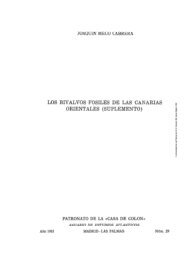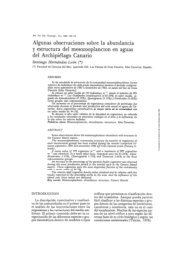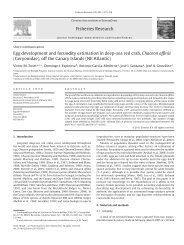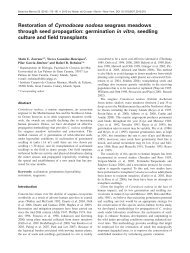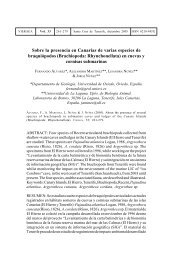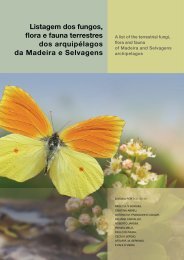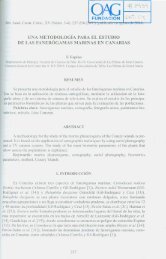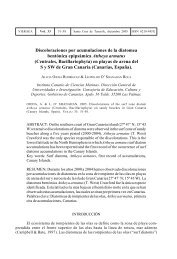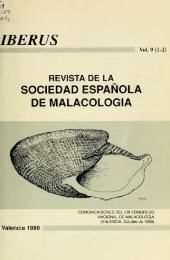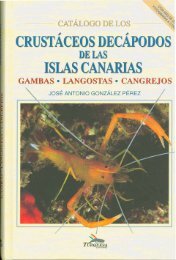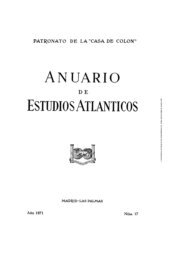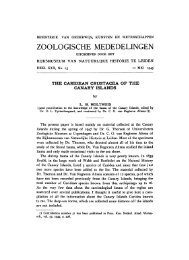A REVIEW OF GERARDIIDAE (ANTHOZOA: ZOANTHARIA ... - redmic
A REVIEW OF GERARDIIDAE (ANTHOZOA: ZOANTHARIA ... - redmic
A REVIEW OF GERARDIIDAE (ANTHOZOA: ZOANTHARIA ... - redmic
Create successful ePaper yourself
Turn your PDF publications into a flip-book with our unique Google optimized e-Paper software.
la, strong current environment, O. Ocaña leg. Sal: we observed colonies in Santa M .<br />
16°35'N 22°54'0, 20-25 m, on vertical waJls and crevices, associated with Tarta<br />
high sedimentation, O. Ocaña leg.; Palmeira Bay, 16°45'N 22°59'0<br />
gate caves, associated to antipatharian, O. Ocaña lego<br />
25 m ver·t·cavlernlc<br />
, , Ica w 1I<br />
a<br />
Morphology: Several ways of growth and external appearances can occu' h<br />
. r In t e<br />
ent new specles. In the case that the colony creates its own skeleton, a basal plate is P<br />
ated where the polyps are asexuaJly produced (Fig. 5e); after this the colon y Contin gen<br />
erating many branches in a single plane or in several of them. Sometimes the spe ~esg<br />
.. . c~<br />
ge~erate a poor developed ~Ibbon hke skele~on, ha:dly notlced without an aCCurateob<br />
vatlon of the colony. GroWIng up on an antlpathanan skeleton is the third way of<br />
showed by this new species, the characteristic spines of those are some identificatio~T0har.<br />
acters in order to distinguish the antipatharian skeleton where the G. rnacaronesica c<br />
occurs. The colonies may reach one meter high.<br />
In preserved material, the polyps measurements are variable between 0,2-1 cm hi<br />
and 0,2-0,5 wide; due to the retraction stage the column can be cylindrical to flat mamm¡.<br />
form; the texture should be roughly by the 90ncentration of sand in the ectoderm of<br />
polyp walJ. In aJive and expanded conditions the sizes increase considerably in two OTthree<br />
centimeters at least. Colonies with small polyps were frequently noticed in the material froII<br />
Cape Verde. The tentac1es present medium size in expanded conditions; they are pointed.<br />
42 in number, arranged in two, more or less, entacmeic cyc1es; we noticed 21 marginal t<br />
The polyps are overhanging from coenenchyme, but extremely embedded polyp<br />
noticed. Wide coenenchyme in the well developed areas with many polyps, fine and I<br />
developed in the extreme areas of the colony.<br />
The species present several colours, from yellow to orange in the tentacles, the<br />
coenenchyme and the column (Fig. 5). As a consequence of the sediment accumulation and<br />
other conditions, not well c1eared, the column can be brownish or whitish, or even pinki<br />
in the column; the brownish column are typical from the colo nies growing on antipathan<br />
ans, although not exclusively. Fixed specimens turned into red colour frequently allhou<br />
orange or brownish are also possible.<br />
Microanatomy and histology: The mesenteries present macrocnemic dispositio<br />
although one specimen showed an intermediate arrangement; there are 28 mesenleries iothe<br />
pharynx region and 42 in the upper column region. Most of the mesenteries are conoected<br />
with a short, low folded pharynx; a single siphonoglyph, larger than wider, is noticed (FI<br />
2d).<br />
The sphincter is well developed and mostly endodermal, aJthough a final portioOo<br />
.<br />
It ISconsldered<br />
. .<br />
mesogleal (see OCANA<br />
- . 5 b) The meseoler<br />
el al, 1995) [25] (see Flgs. a y . an<br />
ial musc1es are poorly developed, we failed in detecting retractor musc1es and weak ~ure<br />
l<br />
etobasilar musc1e only in some mesenteries. The tentacles present also a weak mus cu a<br />
and it is arranged in short process. 1 pre5<br />
The ectoderm present to 80 11mthick, being in the column poorly develo ped<br />
i :iSu<br />
ents glandular ceJls and b-mastigophores; there is afine cuticle that covers the who e '0 the<br />
. 'd tegones, l<br />
The tentacular ectoderm IS well developed and presents several cm om ca e cilia are<br />
pharynx we noticed a few nematocysts, absence of glandular cel1s and larg<br />
observed in the siphonoglyph.<br />
. can reach to 120 Ilffi thick; it presents afine structure and more develm<br />
'sog 1 oea . . .<br />
')1le (;. I than in other anatorrucal areas. We notlced low cel1ular denslty, some<br />
h' "0 umn<br />
110 1 (; ~ d I content have been observed (Fig. 2c); sand incrustations are numerous<br />
. h glan u ar<br />
\\11 art of the column. The mesogloea is hardly noticed in some areas of the<br />
. lhe outer p . .<br />
aaUy10 h harynx wider in the slphonoglyph than In any other area of the pharynx.<br />
nleries aod ld e . p can r~ach to 80 Ilffi thick, it is formed by absorption cells in the col-<br />
Th' codo elm .<br />
e l' dular cel1s among those; commonly, not folded and It presents a low<br />
d some g an .<br />
aO· Mt landular cells are observed along the mesentenes; a very low developlopmeol.<br />
dOd s rgmis noticed in some mesenterical areas. There are filaments unilobuf<br />
lhe en o e<br />
010 '1 h I led (Figs 2 e and f) in the top of the mesenterial filaments. In the speciaod<br />
In o u a· . .<br />
"d we observed gonads development In all the macrocnemes (FIgs. 2 g and h).<br />
o ludle, 'd ( . d l<br />
oidom: A complete survey of t~~ C~l om mea~urements, categones an p acef<br />
h 1alerial from different 10calJtJes IS presented In the table 1. We notlced one catnOolen<br />
. .<br />
of spirocysls and several cate~ones. of the other ~ematocysts eqUlpment: t~ree catery<br />
of elliplical, some of them oVOld,splrulae (b-~astlgophores); one category ISthe sp.eal<br />
pirulae only present in some groups of zoant~ld.s, as the presentogenus. T~ree pemcIlmasligophores)<br />
categones: one category of ellJptlcal to some oVOldpemcIlII A; one cat-<br />
~ of elliplical big penicilli E and other of rather small elliptical to ovoid penicilli E.<br />
lb re are al50 lWOcategories of real, but not very conspicuous, homotrichs of elliptical<br />
pe. a lhird liny category of nematocyst can be assume as a homotrich but it need confir-<br />
1100.<br />
Remarks.- The absence and the presence (or also the range of abundance) of some<br />
adomcalegories found in the studied material of G. rnacaronesica, along the distribution<br />
•should be explained as a part of the specific range of variation displayed by this taxon.<br />
rtheless, lhe different origins of the studied material and, specially, the differences of<br />
onservalion method used, should be also taking in account. Some tiny categories (as the<br />
mall homolrichs fram the wall) may be easily overlooked by the observer; moreover, the<br />
rang of abundance of these capsules categories, in the polyps from different colonies, does<br />
nol have lo be underestimated. Other categories which are not very conspicuous, like the<br />
medlUmsize homotrichs from the filament or pharynx, can be easily overJooked due to its<br />
n morphology and placement. We offer (see Fig. 1) an ideal nematocysts equipment for<br />
macarollesica, although, for identification matters we recommend to use the most common<br />
categories, always present in all the specimens from different populations studied by<br />
u ( e lable 1and Fig. 1).<br />
bit 1: G('/'{¡rdia lila. . .<br />
lJlary I lands COIoneSlca. Survey of the cmdom of five colonies from different localilies. A: El Hierro,<br />
Igas hlcls ¡DZZG-6). B: Santiago, Cabo Verde (DZZG-12). C: Holotype (TFMCBMCN/OOO 188). D:<br />
. lores (DOP n/n). E: Madeira (MMF25715)



